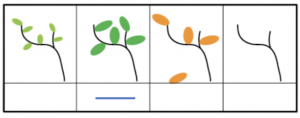Lobelia siphilitica
Great Blue Lobelia
Campanulaceae
Bluebell Family

Great Blue Lobelia is indeed great and blue — a robust perennial reaching as tall as 4 feet, with a conspicuous raceme or “spike” of blue flowers. Note that the flowers are lipped, and the underside of the corolla tube is white-striped. Great blue lobelia is a gynodioecious plant, in which female-only and hermaphrodite individuals coexist in natural populations. The frequency of female plants ranges from 0 to nearly 70% among populations. In hermaphrodites, note that the anthers are fused into a small green melon-shaped sac suspended between the upper two flower lobes. Inspect this with a hand lens: the pollen within the sac is extruded at the tip where a white frill of minute hairs can be seen. Like the closely related Cardinal Flower (p. 18), Great blue lobelia thrives in rich moist soils in mixed sun and shade. They make for a striking display planted together in the garden.
The specific epithet siphilitica was given by Linnaeus in 1753, from specimens collected in Virginia. As the name suggests, syphilis was among the maladies that Native Americans treated with this plant. This particular medicinal use must have figured prominently in the lore of the time for Linnaeus to have so named it. Brought by Europeans to the New World, this fatal disease was indeed spreading like wildfire by the 18th century.

